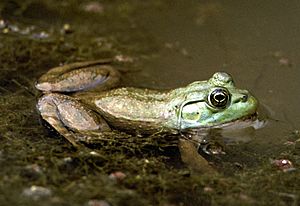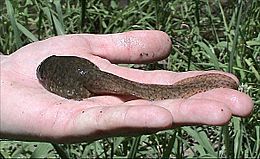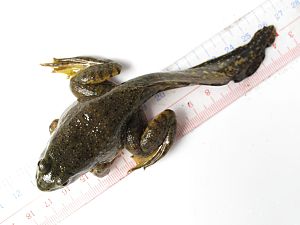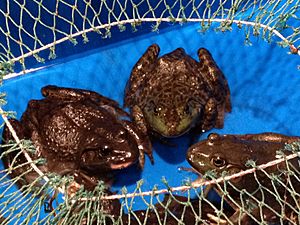Bullfrog facts for kids
Quick facts for kids American Bullfrog |
|
|---|---|
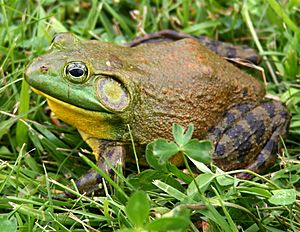 |
|
| adult male | |
| Conservation status | |
| Scientific classification | |
| Kingdom: | |
| Phylum: | |
| Class: | |
| Order: | |
| Family: | |
| Genus: | |
| Species: |
R. catesbeiana
|
| Binomial name | |
| Rana catesbeiana (Shaw, 1802)
|
|
 |
|
| Native range Range as an invasive species | |
The American Bullfrog (Rana catesbeiana or Lithobates catesbeianus) is a large frog that loves water. It belongs to the "true frogs" family, called Ranidae. People call it a "bullfrog" because the males make a loud sound like a bull when they are looking for a mate.
These frogs are originally from North America, including Canada and Mexico. But you can now find them in many other places around the world, like South America, Asia, Western Europe, and the Caribbean. If they live in cold places, they will hibernate during winter. In warmer areas, they stay active all year long.
Bullfrogs can live almost anywhere as long as there is water nearby. They eat many different things, like insects, small fish, rodents, and even other frogs. Because they eat so much, they have sometimes caused problems for other animals. Bullfrogs like to live in big water bodies such as swamps, lakes, and ponds. They usually stay close to the water's edge. They also help by eating mosquito larvae, which can lower the number of mosquitoes. Bullfrogs usually do not move much during the day unless they are looking for food or feel threatened. They might travel on land during a rainstorm to find a new home.
A female bullfrog can lay up to 20,000 eggs at once! Their tadpoles take about a year to grow into young frogs. Male bullfrogs often stay to protect the tadpoles. Males are very territorial and will chase away any animal, even other bullfrogs, that comes too close.
Bullfrogs usually live for about four years. One bullfrog kept as a pet lived for 16 years! Some people do keep bullfrogs as pets. Also, people eat bullfrog legs, and students often dissect bullfrogs in science classes to learn about them.
Contents
All About the American Bullfrog
What's in a Name?
The common name for Rana catesbeiana is the American bullfrog. It is one of about 90 species in the genus Rana, which is a Latin word for "frog." The name "catesbeiana" comes from Mark Catesby. He was an English naturalist who first found and described the bullfrog. The American bullfrog is also known as Lithobates catesbeianus. The family name for Rana is Ranidae, which means "true frogs."
How to Spot a Bullfrog
The American bullfrog is the biggest frog in the "true frogs" family. They can grow to be about 6 to 8 inches (15 to 20 cm) long. They can also weigh up to 1.7 pounds (770 g). Female bullfrogs are usually bigger than males. Bullfrogs can be brown or green. They often have darker spots on their backs.
Bullfrogs have webbed feet that help them swim very well. They can jump as far as 6 feet (1.8 m)! Male bullfrogs make a loud roaring sound when they are trying to find a mate. Males also have larger tympanic membranes, which are like their eardrums. Bullfrogs have brown or gold eyes. They also have wide, flat heads and bodies. Their mouths are small, but they have tiny teeth inside.
Bullfrogs usually live for 4 to 5 years. One bullfrog in captivity lived for 16 years! Bullfrogs have excellent hearing. A group of bullfrogs is called an "army."
Bullfrogs have toxic skin. This means it has a bad taste to other animals, which helps protect them from being eaten. This toxin is not harmful to humans. Bullfrogs can carry many viruses and bacteria, but only a few cause problems in nature.
Bullfrog Homes and Where They Live
Bullfrogs are frogs that live partly in water and partly on land. They are often found near lakes, swamps, rivers, and ponds. They spend most of their time swimming. Bullfrogs are an important food source for other animals. If there is a drought, bullfrogs will leave their home to find water. During a rainstorm, they move faster and can be seen in large groups.
Bullfrogs live naturally in most parts of Canada, Mexico, and the United States. They have also been brought to many other countries. These include Argentina, Belgium, Brazil, China, Colombia, Cuba, France, Germany, Japan, the United Kingdom, and many more. They were often carried by ships to new parts of the world.
Bullfrog Behavior
George Shaw first wrote about bullfrogs in 1802. He described them in his book General Zoology or Systematic Natural History. A bullfrog's call sounds like a slow, deep g-r-r-u-u-u-u-m. Young bullfrogs make a high-pitched chirp before jumping into the water. They do this when they feel scared. Bullfrogs are more active at night. During the day, they might rest under plants. Male bullfrogs are very territorial. They will attack any animal, even other bullfrogs, that comes too close. They might jump, wrestle, or chase animals away.
Hibernation
Bullfrogs in the northern United States go into hibernation during the winter. They hide in the mud at the bottom of ponds and rivers. They can breathe underwater by taking in oxygen through their skin. They can also close their nostrils when they are underwater. While hibernating, bullfrogs can slow down their heart rate and how their body works.
Bullfrogs in warmer southern U.S. states are active all the time. They might only hibernate for a short time if the weather gets very cold.
What Bullfrogs Eat
A study from 1913 found that bullfrogs will eat almost any animal they can catch and swallow. Bullfrog stomachs have been found to contain rodents, baby muskrats, small turtles, snakes, other frogs (even other bullfrogs!), birds, and even a bat. They also eat many invertebrates like insects. Bullfrogs are also known to eat ducklings and tadpoles. Adult bullfrogs help lower the mosquito population by eating their larvae.
Bullfrogs have tiny teeth on the top of their mouths. Their tongues are very good at flipping food into their mouths. Bullfrogs usually eat at night.
If you have a bullfrog as a pet, you might feed it crickets, worms, small fish, rodents, and fruit flies. In the wild, they like to eat crayfish, water beetles, snails, and dragon fly larvae. Bullfrogs will even eat each other sometimes.
Bullfrog Reproduction and Life Cycle
The mating season for bullfrogs starts in spring and ends in early summer. Female bullfrogs are attracted to males who have good territories with lots of food. A male bullfrog will grab the female and start making loud calls. The female bullfrog will also make an aggressive call. The female lays her eggs on the surface of shallow water. Then, the male releases sperm onto the eggs to fertilize them. A female can lay up to 20,000 eggs!
The eggs hatch after about four days. They are called "tadpoles" and live in the water, eating algae. Bullfrog tadpoles are bigger than the tadpoles of other frogs. They take more than a year to become frogs. If they are kept as pets, they can become frogs in just twelve weeks. If a bullfrog tadpole stays a tadpole for more than a year, it will grow into a larger adult frog. This helps them survive better in the wild.
Many animals, like larger fish, crustaceans, and some birds, eat bullfrog eggs and tadpoles. However, bullfrog tadpoles are not very active, so they are less likely to be eaten. Bullfrog tadpoles also taste bad, which is another way they protect themselves.
From Tadpole to Frog
Once the tadpoles become "froglets," they start hopping out of the water and onto land. They lose their tails at this stage. The froglets stop using their gills to breathe and start using their lungs. They begin to eat small insects. These froglets usually stay near the water where they were born. If there is a drought, they will look for a new home. At this time, froglets can easily become food for larger frogs, reptiles, raccoons, foxes, and birds. Froglets become adult bullfrogs about four months after they start hopping on land.
Bullfrogs and Their Impact
The International Union for the Conservation of Nature (IUCN) says the bullfrog is of "Least Concern." This means they are not an endangered species because you can find them on almost every continent. There are more bullfrogs in the southern United States than in the north. However, the number of bullfrogs is going down in some places because of habitat loss, water pollution, pesticides, and too much hunting.
Bullfrogs are an invasive species in places like Puerto Rico and parts of the western United States. They were brought there by fishermen who accidentally carried live frogs, or by pet owners who wanted them to control pests. Bullfrogs have been blamed for causing problems for other native frogs, like the California red-legged frog, which is now a near-threatened species. They have also been blamed for the disappearance of many other amphibians.
How Humans Use Bullfrogs
Bullfrogs are eaten in the Southern and Midwestern United States. People hunt bullfrogs at night near rivers. Their legs are cooked, and their backs are often fried. In California, you need a license to catch bullfrogs for food. In China, bullfrogs are sold alive for eating. They are then killed and cooked with vegetables.
In schools, bullfrogs are often dissected in biology classes. This usually happens in middle school. Dissecting helps students learn about the anatomy (how the body is put together) of a bullfrog.
Bullfrogs are also kept as pets. They can live in aquariums or terrariums. A terrarium is a tank with plants and soil on one side and water on the other. A pet bullfrog needs both land and water areas.
Cool Facts About Bullfrogs
- Male bullfrogs make a sound like a bull, which is how they got their name.
- Bullfrogs are nocturnal, meaning they are more active at night.
- They have a natural toxin on their skin that tastes terrible to predators.
- Bullfrogs can leap as far as ten times their body length!
- Tadpoles can stay in the tadpole stage for up to two years before becoming frogs.
- The temperature of the water affects how quickly tadpoles grow into frogs.
- Iowa, Missouri, and Oklahoma have chosen the bullfrog as their state amphibian.
- One of the most important senses for the bullfrog is hearing.



